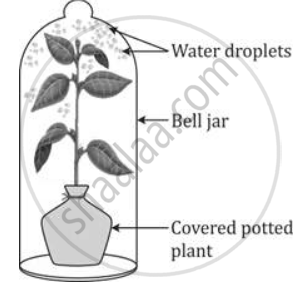Advertisements
Advertisements
प्रश्न
The figure below represents the set-up at the start of certain experiment to demonstrate an activity of plants:
(i) What is the aim of the experiment?
(ii) Why has oil been put in each test tube?
(iii) What will be the observations in the two test-tubes after about 2-3 days?
(iv) Give reasons to explain any change observed as answered in (iii) above.
(v) Why has the test-tube b without the plant, been taken in the experiment?

उत्तर
(i) The aim of the experiment is to demonstrate transpiration.
(ii) To prevent the evaporation of water from the surface.
(iii) The level of water in test tube (a) will decrease.
(iv) The fall in the water level in the test tube (a) is because of transpiration through aerial parts of the plant.
(v) Test tube (b) has been taken as a control experiment. Since no transpiration takes place without the plant.
APPEARS IN
संबंधित प्रश्न
The loss of water in the form of water vapour through stomata on leaves is known as ___________.
Give suitable explanation for the following:
Perspiration and transpiration help to cool the body temperature of the organism.
Give suitable explanation for the following:
On a bright sunny day, the leaves of certain plants roll up.
An apparatus as shown below was set up to investigate a physiological process in plants. The setup was kept in sunlight for two hours. Droplets of water were then seen inside the bell jar. Answer the questions that follow:

Explain the process named above in 7.1.
Name the cell that surrounds the stoma.
What causes the opening and closing of guard cells of stomata during transpiration?
Transpiration is a necessary evil in plants. Explain.
Complete the following by choosing the proper option.
Stomata : Transpiration :: Hydathode : ____________.
Boojho’s uncle was hospitalised and put on dialysis after a severe infection in both of his kidneys.
What is dialysis?
